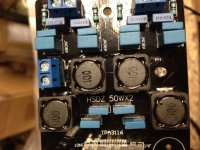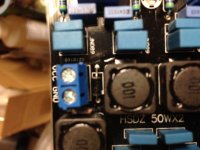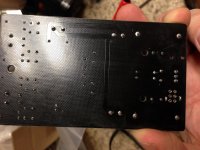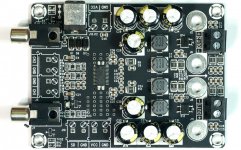bottom shot on the right, pins 31 & 32 are both power supply PVCC,
also shorted on typical application shown in datasheet.
same shot on the left, if that blob on pin 17 (AVCC) is shorting to 18 (PVCC)
it might make a difference if power supply variations when music starts
affects AVCC which goes to LDO inside chip?
...but typical application on datasheet shows those two shorted as well...
is that white triangular area (same photo) showing pins 24 & 25 shorted?
that would be BSPL to ground, which would seem to be a problem.
is it a heatsink pad maybe?
also shorted on typical application shown in datasheet.
same shot on the left, if that blob on pin 17 (AVCC) is shorting to 18 (PVCC)
it might make a difference if power supply variations when music starts
affects AVCC which goes to LDO inside chip?
...but typical application on datasheet shows those two shorted as well...
is that white triangular area (same photo) showing pins 24 & 25 shorted?
that would be BSPL to ground, which would seem to be a problem.
is it a heatsink pad maybe?
Last edited:
Yeah, that white gunge is the thermal compound. I concur with that Quard said RE shorts, there are none which are obvious. You might perhaps want to reflow the chip again if you have access to a hot air tool.
That white triangular area is heatsink glue or something, I highly doubt it's conductive.
And if both 17-18 and 31-32 are shorted in data sheet too, i don't think it is the problem 🙁 . Well, I guess I will need to order another one...
And if both 17-18 and 31-32 are shorted in data sheet too, i don't think it is the problem 🙁 . Well, I guess I will need to order another one...
This board is not made by YJ, but another vendor. HSDC is the acronym. Judging from the lay out of the components, I do not see any changes as compare to YJ black/blue. The vendor claims that the 25 V power cap originally in the YJ board is now replaced with 35V rated Rubycon which should "improve" things. I have one ordered. Just curious what am I going to get. I always find the solder mask of the YJ black looks "funny" as compare to the ususal PCBs.
Regards,
This board is not made by YJ, but another vendor. HSDC is the acronym. Judging from the lay out of the components, I do not see any changes as compare to YJ black/blue. The vendor claims that the 25 V power cap originally in the YJ board is now replaced with 35V rated Rubycon which should "improve" things. I have one ordered. Just curious what am I going to get. I always find the solder mask of the YJ black looks "funny" as compare to the ususal PCBs.
Regards,
Ooops!! Typo, I meant HSDZ.
Regards,
That white triangular area is heatsink glue or something, I highly doubt it's conductive.
And if both 17-18 and 31-32 are shorted in data sheet too, i don't think it is the problem 🙁 . Well, I guess I will need to order another one...
removing power from board and following power off POP takes longer than time between POP's when playing music? if so I think you can focus on outputside capacitors (smaller value??)
The intermittent popping may be bad or cold soldered bootstrap caps, as well as bad input caps that are internally shorted. Given that they are those huge MKP caps I doubt it so would concentrate in the bootstrap caps. Use a DMM to check for shorts and continuity.
I was also surprised to receive a new layout. It has a diode as mentioned as well as LED.
Unlike the picture mine had some holes where perhaps a volume pot could be added. On the otherside of the input are some solder pads that also link to the inputs. Perhaps a nice place for input trafo?
It also seems that they put 1uf after the inductors.
Unfortunately no bootstrap snubbers 😕
The solder mask on the bottom feels rubberized.
Aside from that, I tried the sepf oscons and while not wanting to start any sort of controversy, they definitely do not have more bass than the SilmicII I had in my previous build. Granted I am only 3 hours into it. Do the oscons need a long burn in?
forgot to add pictures 🙄
Attachments
The intermittent popping may be bad or cold soldered bootstrap caps, as well as bad input caps that are internally shorted. Given that they are those huge MKP caps I doubt it so would concentrate in the bootstrap caps. Use a DMM to check for shorts and continuity.
How should internally shorted input caps produce popping? This is nonsense.
How should internally shorted input caps produce popping? This is nonsense.
It may sound like popping, but it is actually the amp going through self-protect auto shutdown and turn-on, which makes the pop, then it shuts down again. This happened to my first TPA3118D2 build (long before Chinese boards were available) when I accidentally heated an SMT input 1uF cap too long with the soldering iron. Tie one of the input pins to GND (without the bypass cap) and see if you can get your amp to work. It pops doesn't it?
You shouldn't call things you don't know nonsense.
How should internally shorted input caps produce popping? This is nonsense.
***
I had a tube amp that developed popping that was traced to an intermittently shorting coupling capacitor (when shorted it allowed DC to pass, which produced the popping). The problem was solved by replacing the capacitor.
I don't know that a bad cap is in fact the cause of the 3116 amp popping that's being complained about, but it's not impossible and needs to be ruled out.
It may sound like popping, but it is actually the amp going through self-protect auto shutdown and turn-on, which makes the pop, then it shuts down again. This happened to my first TPA3118D2 build (long before Chinese boards were available) when I accidentally heated an SMT input 1uF cap too long with the soldering iron. Tie one of the input pins to GND (without the bypass cap) and see if you can get your amp to work. It pops doesn't it?
You shouldn't call things you don't know nonsense.
This must be it then, I accidentally heated the cap too, I tought its just the cover and no harm was done .. So I will buy one today. Thanks for the help 🙂
This must be it then, I accidentally heated the cap too, I tought its just the cover and no harm was done .. So I will buy one today. Thanks for the help 🙂
Bad contact or bad capacitor in any position could give popping you mentioned.
Quick opinion from the experts 🙂:
1) which stock 3116 boards, that are readily available, offer the best SQ? Sure?
2) is 3110 or 3116 better for mids and high frequency SQ?
long story short, I'm planning to amp my active 4-way system with 3116/3110. For bass I planned 3116, and for 2" comp driver and super tweeter either 3110/3116 is OK, whichever has better SQ. I will do some basic mods like change the filtering caps on the PCB, but I would like to keep the modding to a minimum, hence the best stock-sounding board.
PSU will be 50-80Ah AGM car battery + local high speed filter cap bank + the filtering that is on the amp PCB. So rail will be 12,8V - 14,4V depending if the Ctek MXS 5.0 smart battery charger is connected or not.
1) which stock 3116 boards, that are readily available, offer the best SQ? Sure?
2) is 3110 or 3116 better for mids and high frequency SQ?
long story short, I'm planning to amp my active 4-way system with 3116/3110. For bass I planned 3116, and for 2" comp driver and super tweeter either 3110/3116 is OK, whichever has better SQ. I will do some basic mods like change the filtering caps on the PCB, but I would like to keep the modding to a minimum, hence the best stock-sounding board.
PSU will be 50-80Ah AGM car battery + local high speed filter cap bank + the filtering that is on the amp PCB. So rail will be 12,8V - 14,4V depending if the Ctek MXS 5.0 smart battery charger is connected or not.
Last edited:
The Ybdz 2.0 or "Weiner" is a good stock board. Very good tight layout and good SQ. I use them in an active miniDSP system. Replacing stock power rail caps with OSCON's inproves SQ. Adding bootstrap snubber improves further. Those are only two mods needed. Stock inductors do not get hot. Snap on screw terminal headers allow easy speaker and power connections.
Quick opinion from the experts 🙂:
1) which stock 3116 boards, that are readily available, offer the best SQ? Sure?
2) is 3110 or 3116 better for mids and high frequency SQ?
long story short, I'm planning to amp my active 4-way system with 3116/3110. For bass I planned 3116, and for 2" comp driver and super tweeter either 3110/3116 is OK, whichever has better SQ. I will do some basic mods like change the filtering caps on the PCB, but I would like to keep the modding to a minimum, hence the best stock-sounding board.
PSU will be 50-80Ah AGM car battery + local high speed filter cap bank + the filtering that is on the amp PCB. So rail will be 12,8V - 14,4V depending if the Ctek MXS 5.0 smart battery charger is connected or not.
I don't claim to be a 3110/3116 expert, but since you're limited to 12 volt battery power, why not just use the 15 watt Sure 3110? With your planned PS, the 3110 will have the same output power as the 3116. My neighboor is currently using 4 of the 15 watt Sure boards with miniDSP 2x4's. They sounded damn good out of the box in my JBL Pro equipped barn theater, although he might have changed the gain on the mid and high boards to knock down some hiss, since. If a switch is wired between SD and GND terminals there is a very slight on/off pop.
If you order 4 or more from the official Sure ebay store, quantity and shipping discounts apply. IIRC the cost averaged to under $12 USD per board, shipped, when we ordered.
2 x 15Watt 8ohm Class D Audio Amplifier Board TPA3110 HiFi | eBay
Attachments
Last edited:
I don't claim to be a 3110/3116 expert, but since you're limited to 12 volt battery power, why not just use the 15 watt Sure 3110?
That's what I was thinking at first and i know the output power will be PSU voltage limited, but I though that the big brother 3116 would still perhaps be better at controlling my big woofers because the series ferrites would propably have less DC resistance to allow bigger amperage (?) and the 3116 chip itself is propably happier (?) driving 4ohm quite reactive (horns) loads which both my sub/midbass are. But those are just presumptions. What do you think?
Do they both have nearly identical layout otherwise, ie. full wave bridge rectifier at the output, bootstrap snubbers, same amount of local SMD DC filtering caps etc... (I read 3116 has lots of local SMD filtering which is good)?
Last edited:
Legis,
You're letting the horse drive the cart. I suggest you drive the cart.
The issue is that you're limited to a 12 volt power supply.
I've tried the 3116 with both a 12 volt battery and now with an 18 volt battery (3x 6v batteries in series). It performs much better at the higher voltage, with higher amperage and power out that translates to much better driver control, transients, imaging, dynamics, and openness.
You can charge the batteries individually with a 6v charger or you can get an 18v charger and charge the entire set of batteries in one fell swoop (I'm using one designed for the Honda Minimoto scooter - if I ever get a scooter I'm already set).
Upgrade your battery and go with the 3116. That's my suggestion based on my personal experience.
You're letting the horse drive the cart. I suggest you drive the cart.
The issue is that you're limited to a 12 volt power supply.
I've tried the 3116 with both a 12 volt battery and now with an 18 volt battery (3x 6v batteries in series). It performs much better at the higher voltage, with higher amperage and power out that translates to much better driver control, transients, imaging, dynamics, and openness.
You can charge the batteries individually with a 6v charger or you can get an 18v charger and charge the entire set of batteries in one fell swoop (I'm using one designed for the Honda Minimoto scooter - if I ever get a scooter I'm already set).
Upgrade your battery and go with the 3116. That's my suggestion based on my personal experience.
Last edited:
Legis,
You're letting the horse drive the cart. I suggest you drive the cart.
The issue is that you're limited to a 12 volt power supply.
I've tried the 3116 with both a 12 volt battery and now with an 18 volt battery (3x 6v batteries in series). It performs much better at the higher voltage, with higher amperage and power out that translates to much better driver control, transients, imaging, dynamics, and openness.
Hi Les, were the 12V and 18V supplies otherwise almost the same, ie. were the batterie's output impedance/short circuit current output capability nearly the same and the psu filtering caps at the same amount/quality level?
I have also thought to put two identical car batteries in series to create a 24V system, then regulate it to 18V or 20V with little army of linear regulators in parallel, but I suppose this would be inferior option compared to "direct out" from 12.8-14.4V battery (direct out = less noise, propably lower output impedance). Big battery is quite ideal power supply for a dynamic load because it's short circuit current output can exceed 1000A, even 2000A. One must have "quite" thick cabling and low contact resistance pathway to reap all the benefits the supply can offer. 🙂
Last edited:
- Home
- Amplifiers
- Class D
- TPA3116D2 Amp





